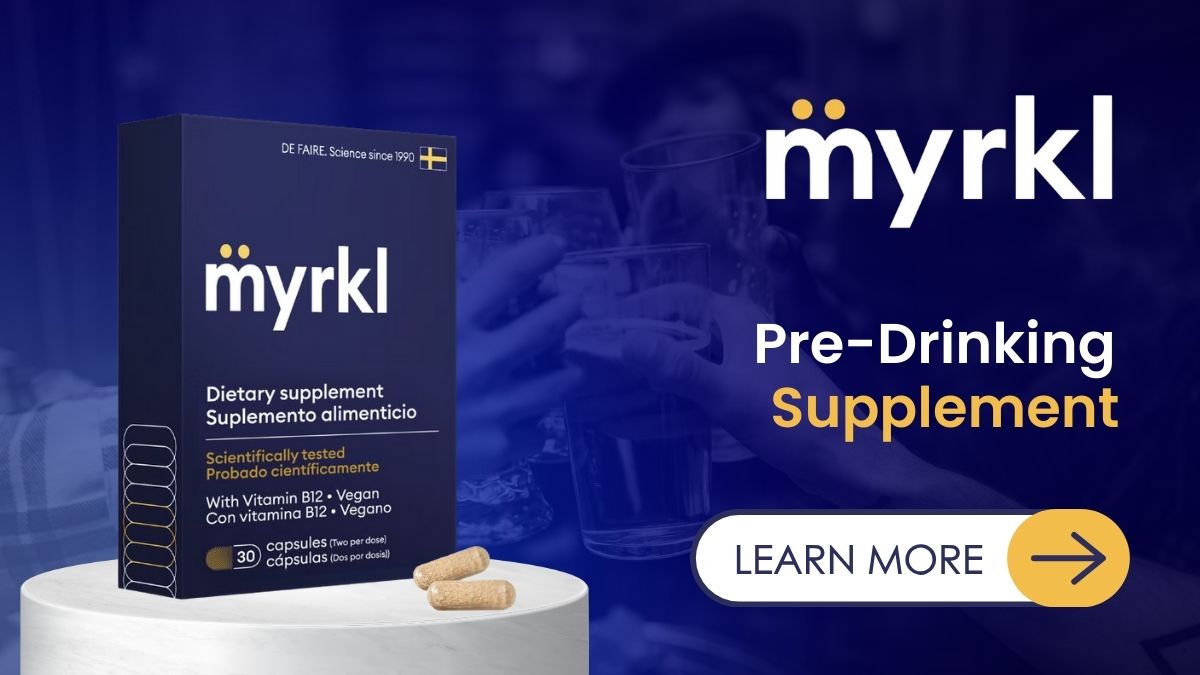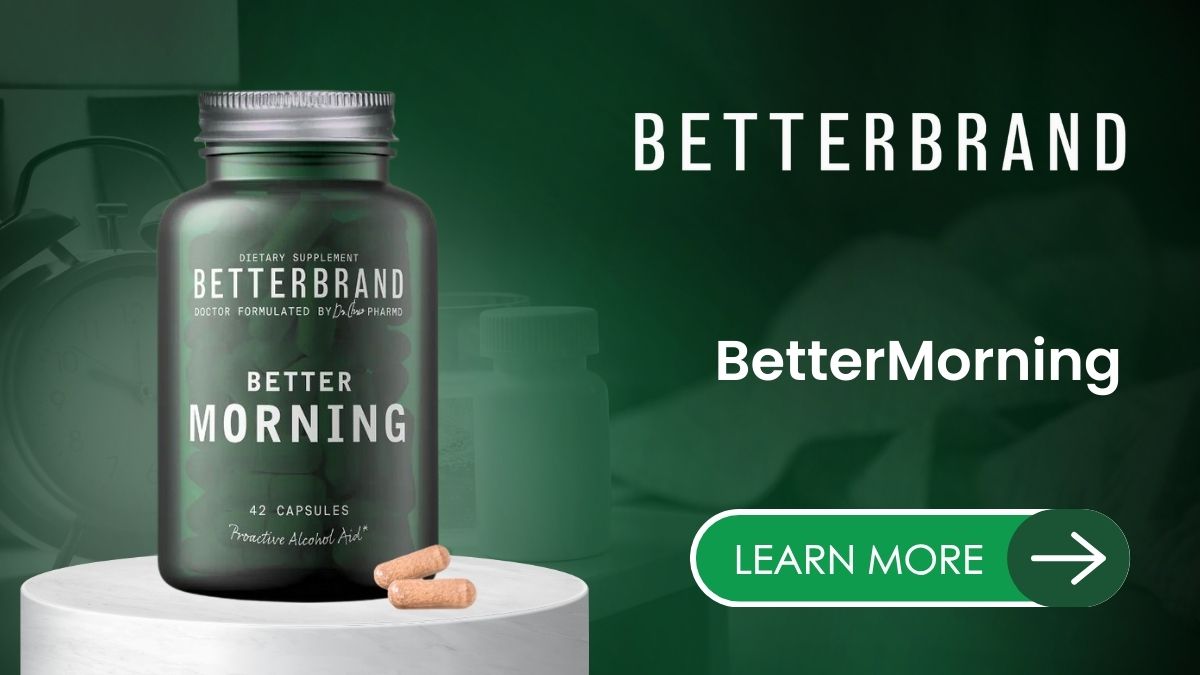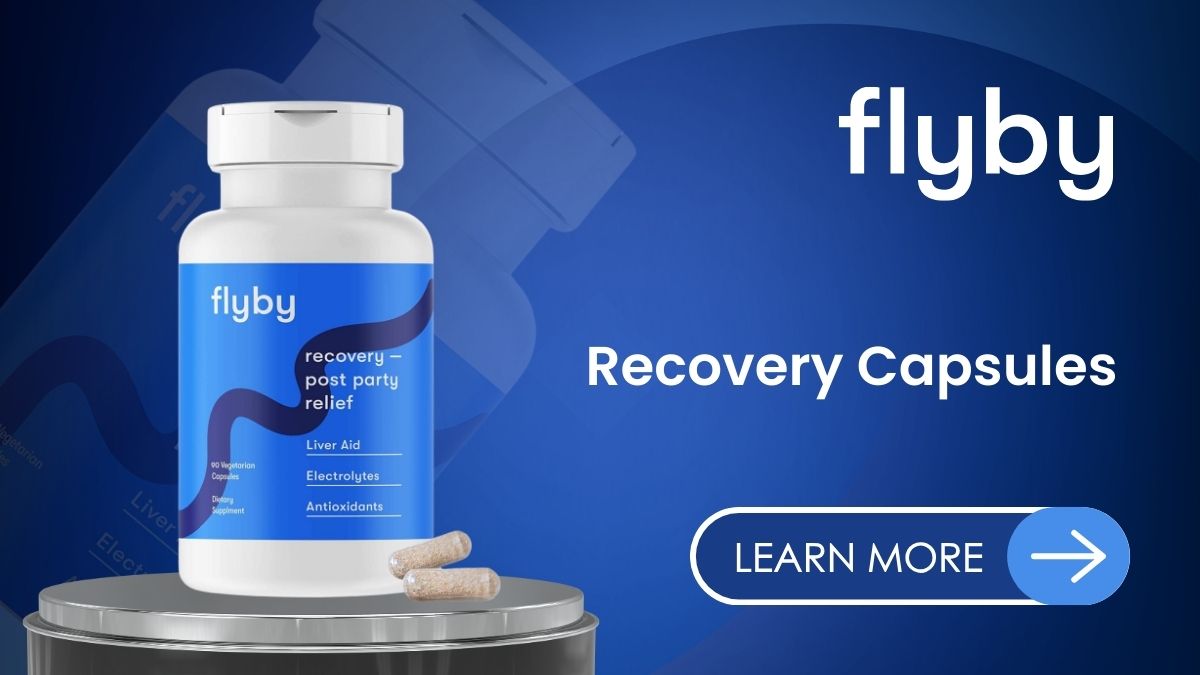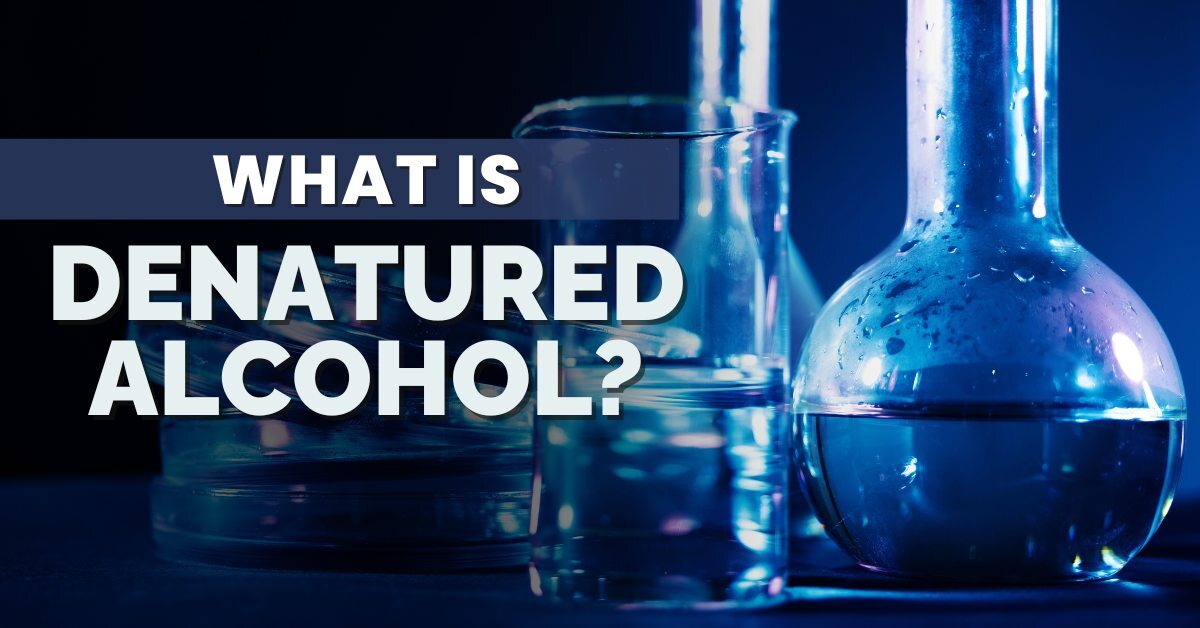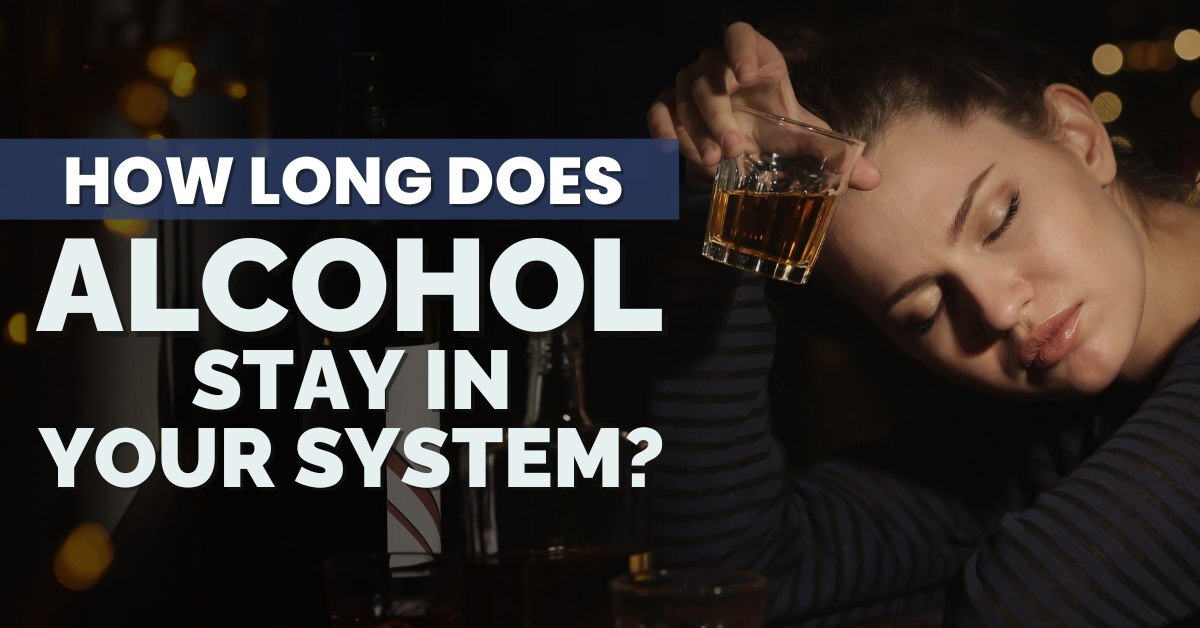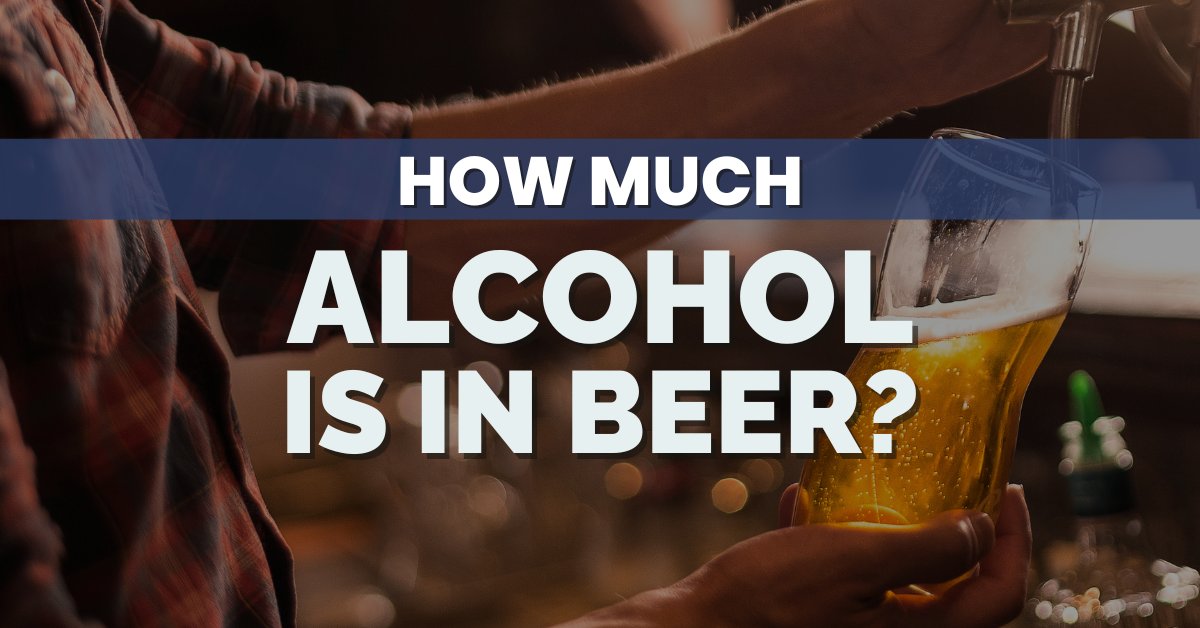
How Much Alcohol Is in Beer? Percentage Content Based on Beverage Type
Wondering how much alcohol is in beer? Even though beer has some of the lowest alcohol levels, it’s still vital to pace yourself for health or social reasons.
The usual alcohol content of beer is between 4–5%. Stouts, IPAs, and many craft beers are typically higher; light and low-alcohol beers are much lower. But planning ahead is always better than waking up with a hangover later or failing an alcohol breath test.
Our guide will help you figure out how much alcohol is in beer, including the various types of this popular beverage. We will also talk about how the best hangover pills—like Myrkl—can help you recover from a hangover after enjoying beer.
What Is the Typical Alcohol Content of Beer?
So, how much alcohol is in beer in general? Well, the usual alcohol content of beer is between 4–5%. Stouts, IPAs, and many craft beers are typically higher; light and low-alcohol beers are much lower.
A 2000 survey of almost 400 different beers and malt beverages sold in Washington found that the ABVs ranged from around 2.92% for one ale to 15.66% for a bock. Bock is usually a sweet, strong type of lager. Most hovered between 4–6% ABV. There were also two non-alcoholic beers, despite it being an older survey [1].
How Is Alcohol in Beer Measured?
Alcohol content can be measured in two ways: Alcohol by Volume (ABV) and Alcohol by Weight (ABW).
Small manufacturers use simple tools for this. For example, they may use a hydrometer—which measures liquid density—before and after the drink is fermented. Alcohol is less dense than sugar, so the change in depth indicates ABV.
Another tool is the refractometer, which measures how light refracts (or changes direction) in a substance. This changes as more sugar transforms to alcohol.
Larger manufacturers often turn to distillation—which separates alcohol—or gas chromatography. This separates the parts of a liquid and accurately measures them [2].
While ABV and ABW use percentages, the proof measurement is more complicated and measured in different ways. In Great Britain, “100 proof” actually means 57.06% ABV. This is because it means the beverage is 12/13 of the weight of distilled water at 51F. In the US, 100 proof indicates an ABV of 50% [3]. It is usually used for liquor, not beer or wine.
What Does ABV Stand For?
As we mentioned above, ABV stands for Alcohol By Volume. This is a standard measurement used around the world to measure alcohol content. Unlike the more complicated proof system, it is a percentage of the beverage’s total volume that is made up of alcohol. For example, if a beer is labeled as 5% ABV, it means that 5% of the liquid is alcohol.
The calculations for finding the ABV involve measuring the original gravity (OG) before fermentation and the final gravity (FG) after the fermentation process. Manufacturers use the difference between the two measurements to find the ABV.
Here’s the basic formula to give a close estimate of how much alcohol is in beer in terms of percentage:
- ABV = (OG – FG) x 131.25
What Is High-Point Beer?
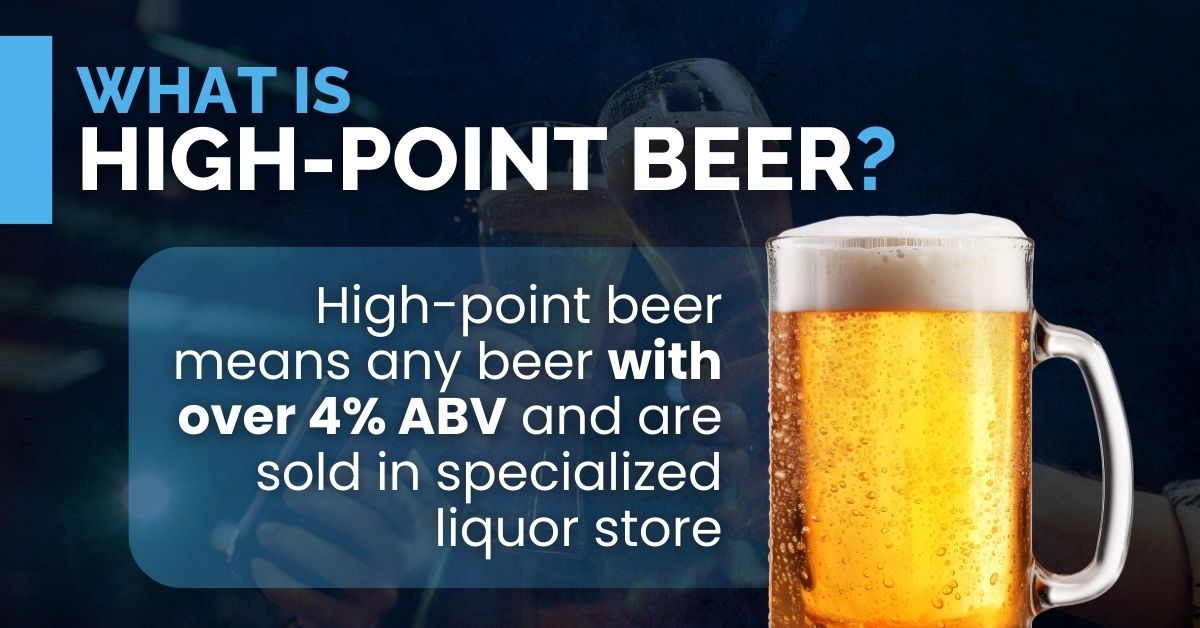
High-point beer usually means any beer with an ABV over 4%. It’s typically seen as a legal definition, limiting where certain beers can be sold.
Most US states allow beer with an ABV of less than 4% to be sold in grocery stores. Some even place the upper limit at 3.2%. In short, anything above the “high point” limit must only be sold in a specialized liquor store.
Beer Categories Based on Alcohol Content
If you’re curious to know how much alcohol is in beer, you should check if they’re categorized as standard, high-alcohol, low-alcohol, or non-alcoholic.
High-Alcohol Beers
High-alcohol beers are often intentionally made to be stronger, or they may simply be made with different ingredients and techniques.
Craft beers—known for their unique flavors and brewing techniques—can have ABVs ranging from 6% to 10%… and sometimes even higher.
And how much alcohol is in beer vs wine? You may see beers with ABVs of 15% or over, similar to how much alcohol is in wine. Laws around high-point beer may contribute to their niche status, as they have fewer avenues for sale.
The strongest beers reach levels seen in distilled spirits, such as the alcohol percentage in rum or vodka. For instance, Snake Venom Ale by Scotland’s Brewmeister has an impressive 67.5% ABV. Brewmeister also manufactures Armageddon, which has a 65% ABV. The bronze medal goes to Koelschip’s Start the Future, at 60% ABV.
As for US-origin beers, Samuel Adams Utopias by the Boston Beer Company takes the top position with a 29% ABV. Another, Herkimer Toripuru Strong Bock, contains 23% alcohol.
Standard Beers
How much alcohol is in a can of beer? A “standard” beer in the US typically contains about 5% ABV (mostly between 4.5% and 5.5%). This is a baseline from which other beers can vary. Another term for standard beers is “regular” beers. One 12-ounce standard beer also matches the definition of a “standard” drink.
Standard beers are the easiest type for you to track your alcohol consumption. In general, it takes one standard drink for a 140-pound man to have a blood alcohol level (BAC) of 0.04%; a woman weighing 120 pounds is likely to have a BAC of 0.06% [4].
Two standard drinks will increase these levels to 0.09% and 0.11%, respectively, which are both over the legal limit for driving. As the BAC drops by an average of 0.015% per hour, a man will need to stop drinking for one hour before he can drive, while a woman must do so two hours before she takes the wheel again [3].
Gluten-free beers are an inclusive option that caters to those with celiac disease and other folks who are sensitive to gluten. These drinks are made with grains such as quinoa, millet, and sorghum instead of barley and wheat. Some include traditional flavorings such as orange peel, too. There are no differences in alcohol content, so you won’t miss out on that buzz.
Low-Alcohol Beers
Low-alcohol beers (a.k.a. “session” or reduced-alcohol beers) have an ABV anywhere between 0.5% and 4.5%. These beers provide a middle ground for those who enjoy the overall sensory experience of beer but wish to moderate their alcohol intake.
Many people love low-alcohol beers for their lower caloric and sugar content. They support a healthier lifestyle while still delivering the same flavors and mouthfeel. The name “session beer” comes from how you can drink more bottles in one session with fewer or no adverse effects, such as a hangover.
They are different from the term “light beer,” which typically refers to beers with an ABV of around 4.2% in the United States. These may be sold as a near-identical version of standard beers, with the main difference being less alcohol.
You may want to avoid everything but low- or no-alcohol beers for health reasons. Certain medications—such as tricyclic antidepressants and even over-the-counter NSAIDs—might cause more side effects when taken together with alcohol. For example, Warfarin’s effects can either be strengthened by short-term alcohol consumption or reduced by chronic drinking [5].
Additionally, people with diabetes may experience alcohol-induced hypoglycemia. This is because alcohol reduces your liver’s ability to release sugar into the bloodstream. If you have diabetes, it’s a good idea to limit your alcohol consumption to one standard drink every two hours. Light beer is usually recommended over others as it’s lower in sugar [6].
Non-Alcoholic Beers
How much alcohol is in non-alcoholic beer? Non-alcoholic beers contain as close to no alcohol as possible. They can have up to 0.5% alcohol, however. These are ideal if you cannot have alcohol due to health reasons but want to enjoy the flavor and mouthfeel of beer. It is virtually impossible to be intoxicated from an ABV this low.
To put things in perspective, fruit juice can have an ABV of up to 0.11% because of the natural fermentation of orange or grape juice. Additionally, the fermented drink kombucha also has trace amounts of alcohol. This is usually less than 0.5% ABV, too little to require labeling or accumulate in your body faster than it can be removed.
Sweet, spicy root “beer” is not beer by our usual modern definition and is more like a sweet soda, usually non-alcoholic. The drink is made from the root bark of Sassafras albidum or from Smilax ornata, the sarsaparilla vine. You can find “hard” root beer, however. Many ginger beers are non-alcoholic, too.
Some researchers propose that beneficial nutrients in beer (such as antioxidants) have their chance to shine in alcohol-free beer. Their results show that it could boost your body’s antioxidant status to protect your cells while improving cholesterol levels. Some even revealed improved immune function and blood vessel health [7].
Alcohol Content Across Beer Styles
Each beer style offers a distinct combination of flavor, aroma, and alcohol content. Do you prefer the light and reinvigorating nature of a lager or the bold, deep flavors of a stout?
Understanding how much alcohol is in beer (and their flavor profiles too!) can help you choose the types of alcohol beverages that perfectly match your taste preferences and intake limits.
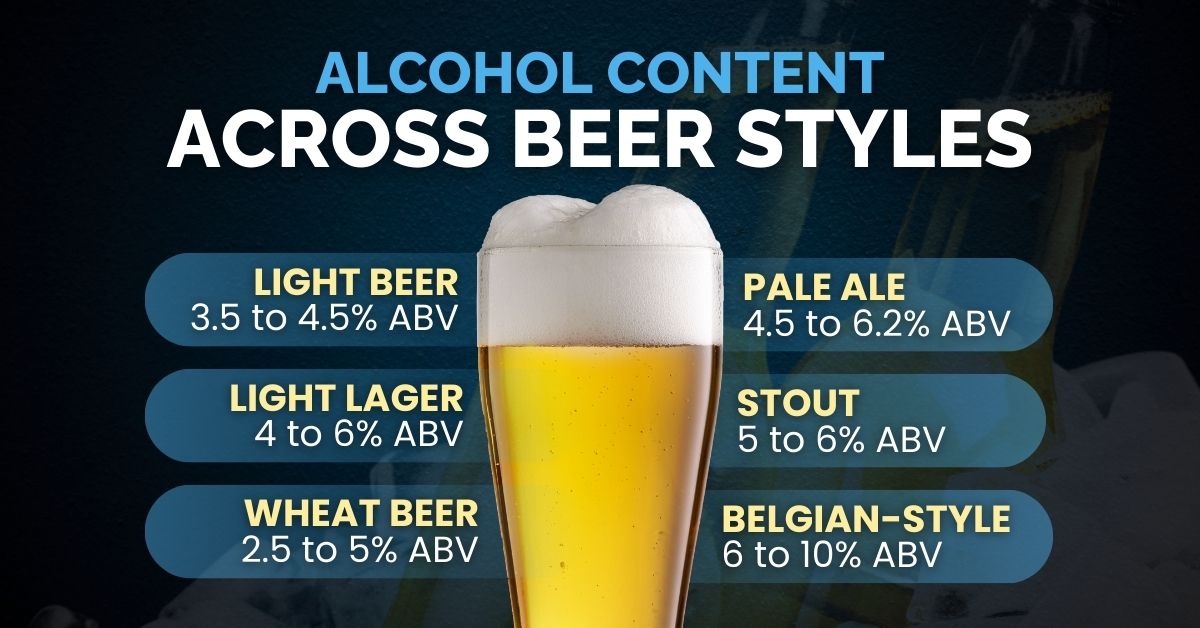
Light Beer
Light beers have refreshing flavors and mouthfeels. Their usual ABV hovers between 3.5% and 4.5%, making them slightly lower in alcohol than a standard beer.
They are winning over more customers thanks to their lower calorie content. Many have less than 100 calories per bottle. The flavors are less intense as well, making them more rejuvenating as a result. As they are less filling, you can drink them without feeling bloated, improving their overall sensory experience.
The simplest way to make a light beer is to dilute the original mixture. Reducing the amount of grain and malt, along with extending the mashing time, are also common methods. Mashing is the process where grains are broken down into sugars and proteins that will be eventually used to make the final product.
To make low-alcohol beers, manufacturers sometimes craft them with barley malt, corn syrup solids, rice extracts, or a combination of these.
Light Lager
Lagers are known for their crisp and invigorating taste, which is partly due to how they’re fermented. Generally, lagers have an ABV ranging from 4% to 6%, with light lagers having an ABV between 2.5–5%.
A light lager is often made with corn, rice, or both to lighten the beer. They are light and dry with little to no malt. European versions may have more malt and flavor, so drinking abroad will give you an entirely different experience.
On top of this, lagers are more carbonated, making them exceptionally bubbly. However, light lagers also have the least flavor.
Wheat Beer
Wheat beer often has an ABV between 2.5% and 5%. Some American varieties can reach up to 7%, so always read the label if you want to carefully pace yourself.
Wheat beers use more wheat than malted barley in their recipes. A German weissbier will have at least 52% wheat to barley malt. The Dutch version, known as witbier, often includes flavors like orange peel and even coriander (a heads up if coriander tastes like soap to you).
Wheat beers are overall more fruity and less bitter thanks to their different fermentation products. For example, the hefeweizen wheat beer has banana and clove notes because of the yeast strain saccharomyces cerevisiae var. diastaticus.
Pale Ale
Pale ales are known for their balanced malt flavors, often accompanied by a hoppy bitterness. Their bitterness levels usually range from 20 to 50 International Bitterness Units. They typically feature a range of subtle flavors—such as biscuit and light caramel notes. The ABV for pale ales typically ranges from 4.5% to 6.2%, similar to standard beers.
India Pale Ales (IPAs) are popular for their strong hop flavors and higher ABV, which generally lies between 5% and 7.5%. You can find ABVs of 10% or more among the double IPAs. Their stronger alcohol content gives them a bolder taste, too. However, they also have an IBU rating of around 100, so they might not be a good fit if you don’t enjoy bitter flavors.
On the other hand, American pale ales have a mid-range alcohol content by pale ale standards. Their flavor profiles have more citrus and even tropical fruit notes. Belgian pale ales are less bitter, with IBUs from around 20 to 30.
To make pale ales, brewers will combine pale malt with ale yeasts. They lie between light lagers and heavy stouts in terms of flavor. Their malt is dried with high-carbon coke (a gray coal-based fuel) instead of the wood responsible for darker colors. This is because coke smoke burns cleaner with less soot than wood.
Stout
Stouts are rich, dark beers with a deep flavor profile that typically features coffee, chocolate, and caramel notes. Their dark color comes from how their malt is traditionally dried with wood or peat-fuelled fires.
How much alcohol is in beer pints for the stout variety? The ABV for stouts can vary widely—with traditional versions around 5–6% and more robust varieties like imperial stouts reaching ABV levels of 8% or even more.
This style is known for its creamy texture and complex flavor profile, often enhanced by the addition of ingredients like oats or lactose:
- Milk stouts contain lactose, which are great if you want a sweeter, creamier, and more velvet-like drink
- Oatmeal stout uses up to 30% oats and are smoother in texture
- Chocolate and coffee stouts are simply made from more heavily roasted malt, but some brewers add coffee beans as well
Belgian-Style Ale
Belgian-style ales are known for their strong, complex flavors and higher alcohol content, typically ranging from 6% to over 10% ABV. These ales often feature fruity and spicy notes that come from unique yeast strains, with a high carbonation level that uplifts the sensory experience.
There is a great diversity of flavors in Belgian ales. For example, malty Flanders brown ales have plum, date, and fig flavors. Belgian pale ales have peppery aromas mixed with fruit notes. Dubbel, tripel, and quadrupel Belgian ales include the unique ingredient of beet sugar; it gives them a raisin-like flavor and enhances their other fruity flavors such as apple and pear notes [6].
Beer ABV and ABW Values
While ABV is the typical way of measuring how much alcohol is in beer, it may be less accurate than using alcohol by weight (ABV). To switch between the two, the formula is ABV = (ABW x (FG / 0.794).
ABW considers the density of the beer. Using ABW controls for variations in ingredient density and alcohol content. Some claim it provides a more accurate reading, especially in stronger beers.
Despite this, ABW is rarely seen as a measurement. Arkansas, South Carolina, Kansas, Mississippi, and Tennessee tax alcoholic drinks based on ABW. Utah once officially used ABW, but has since switched to ABV.
Best Hangover Pills
Hoping to avoid a rough morning after a night of drinking beer? No worries, you can try natural hangover supplements or see if alcohol alternatives work for you to prevent hangovers from happening in the first place.
1. Myrkl
Myrkl is a pre-drinking supplement that combines probiotics, prebiotics, vitamin B12, and l-cysteine to boost your metabolism and keep your liver healthy. It promises that the vegan-friendly formula can help you avoid feeling too tired after enjoying beer and other alcoholic concoctions. Just take two capsules around two hours before you go drinking.
>>Check the latest prices for Myrkl here
2. BetterMorning by BetterBrand
BetterBrand claims that BetterMorning—which packs together ginger, licorice extract, milk thistle, and alpha-lipoic acid (ALA)—can help you overcome headaches and other effects of alcohol. It flushes out toxins from your liver while replenishing the nutrients your body lost by supplying you with B vitamins. Pop three pills before, after, or even while drinking beer.
>>Check the latest prices for BetterMorning by BetterBrand here
3. Flyby Recovery Capsules
If you struggle with “hang-xiety,” Flyby Recovery Capsules allow you to bounce back faster after chugging down beer. Featuring DHM, prickly pear, B vitamins, and milk thistle, it restores the minerals, vitamins, and amino acids to your body. You should take three capsules before drinking and then another three afterward to recover (or possibly stay sober longer)
>>Check the latest prices for Flyby Recovery Capsules here
FAQs About Alcohol and Beer
Here are the first questions people ask when evaluating the alcohol content of beer.
How Much Alcohol Is in a 12 Oz Beer?
A glass with twelve ounces of regular beer—or one standard 350 ml drink—contains 14 grams of alcohol or 5% ABV. A low-alcohol beer with a 2.5% ABV will therefore have seven grams, while a higher-alcohol type with 10% ABV contains 28 grams.
What Percent Alcohol Is Beer?
Curious to know what percentage of alcohol is in beer? Beer is usually between 4% and 5% alcohol, but the strongest can reach 10–15% or even over 60% in extreme cases. You can also buy low-alcohol alternatives with even less than 4% ABV.
Is 1 Beer Equal to 1 Shot of Liquor?
How much alcohol is in beer pints compared to liquor shots? Well, one shot of liquor and one regular beer typically contains the same amount of alcohol, which is one standard drink. A shot of liquor is, however, much smaller in volume. This means you can drink more beer, as it has less than the alcohol percentage in whisky or how much alcohol is in vodka.
Is 5% Beer Alcohol Strong?
No, 5% ABV beer is considered regular-strength. It may be considered “high-point” beer, meaning it is over the limit that prevents it from being legally sold in grocery stores. Now, if you ask “Is 40% alcohol strong?” then the answer would be yes.
Final Thoughts on How Much Alcohol Is in Beer
The answer to “How much alcohol is in beer?” can seem like it opens up more questions than it resolves.
Between the light beers with as little as 2.0% ABV, to the experimental craft beers that can reach over 60% ABV, there’s a staggering amount of diversity. You can even find alcohol-free beers with ABVs lower than 0.5%; this is removed from your body faster than you can drink it.
However, you will typically find beer with an ABV of 4%-10%. The popularity of beer is so great that a 12-ounce regular beer with a 5% ABV may have set the benchmark for the “standard drink.”
Now that you know how much alcohol is in beer, it will be easier for you to pick the right beer type for you. Even better, you probably also have a better idea of how to get over a hangover with the help of Myrkl and other natural supplements after enjoying your favorite beer.
>>Get rid of hangovers with Myrkl now
References
- Case, G. A., et al. “Tabulation of Alcohol Content of Beer and Malt Beverages.” Journal of Analytical Toxicology, vol. 24, no. 3, 1 Apr. 2000, pp. 202–210, https://doi.org/10.1093/jat/24.3.202. Accessed 2 Nov. 2020.
- Henderson, Sarah. “How Do You Measure the Percentage of Alcohol in Beer, Wine and Other Beverages?” NIST, 20 May 2021, www.nist.gov/how-do-you-measure-it/how-do-you-measure-percentage-alcohol-beer-wine-and-other-beverages.
- “Proof | Alcohol Content, Distillation, Spirits | Britannica.” Www.britannica.com, www.britannica.com/topic/proof-liquor.
- Stim, Richard. “Blood Alcohol Level Chart: Are You Too Drunk to Legally Drive?” Dui.drivinglaws.org, Nolo, 7 July 2010, dui.drivinglaws.org/drink-table.php.
- Weathermon, R, and D W Crabb. “Alcohol and Medication Interactions.” Alcohol Research & Health : The Journal of the National Institute on Alcohol Abuse and Alcoholism, vol. 23, no. 1, 1999, pp. 40–54, www.ncbi.nlm.nih.gov/pmc/articles/PMC6761694/.
- Sancén, Marco, et al. “Features of Non-Alcoholic Beer on Cardiovascular Biomarkers. Can It Be a Substitute for Conventional Beer?” Nutrients, vol. 15, no. 1, 1 Jan. 2023, p. 173, www.mdpi.com/2072-6643/15/1/173, https://doi.org/10.3390/nu15010173.
- “A Beginner’s Guide to Belgian Beer Styles.” Serious Eats, www.seriouseats.com/guide-to-belgian-beer-styles-what-is-dubbel-quad-saison-wit-lambic-gueuze.



